
Entrance to hospital emergency department at St Vincent's Hospital in Melbourne, Australia. The sign is red with the word EMERGENCY prominently displayed. It can be used to illustrate various healthcare, medical and emergency concepts, from afflictions such as stroke or heart attack, diseases such as HIV or cancer, and accidents such as road trauma or sporting injury. (Getty Images/iStockphoto)
Despite an explosion of clinics in U.S. stores and shopping malls that can handle minor illnesses and injuries, emergency room visits for these non-emergency problems have barely decreased, researchers say.
More than 10 percent of emergency department (ED) visits are for ailments that could be treated outside the ED, which would help cut down on crowding that can compromise the care of patients with real emergencies, the study team writes in Annals of Emergency Medicine.
People use the ED for many reasons, including serious issues like heart attack, strokes and injuries, said lead author Grant Martsolf of RAND Corporation in Pittsburgh, Pennsylvania.
"Others, instead, use EDs more like primary care providers for more minor conditions such as ear infections and coughs and colds. These minor conditions are those that might be better treated at less expensive locations such as a retail clinic," Martsolf told Reuters Health by email.
Store clinics offer support for minor medical issues and tend to have flexible hours, lower wait times and accept most insurance types, the researchers write.
Between 2006 and 2012, the number of retail clinics in pharmacies, big box stores and stand-alone "urgent care" facilities rose from 130 to nearly 1,400, the authors write.
To explore how the availability of these clinics affected nearby emergency rooms, the study team analyzed data on visits to 2,053 EDs in 23 states between 2007 and 2012.
In particular, the researchers looked at visits to the ED for minor complaints that could be treated at clinics, such as bronchitis, pink eye, flu, ear infections, sore throats, urinary tract infections and viral infections.
They also looked at how much of the local area served by each emergency room was within a 10-minute drive of a retail clinic.
Over the five-year study period, the proportion of EDs that were within quick driving distance of retail clinics doubled from 8 percent to 16 percent.
At the start of the study, about 13 percent of emergency room visits were for minor conditions.
Overall, having more retail clinics open nearby was not linked to a decrease in people coming to the emergency room with minor complaints, compared with areas that did not gain more clinics.
During the study period, ED visits for minor issues decreased slightly among people with private insurance, but not among uninsured people or those receiving Medicaid or Medicare.
"Emergency room overcrowding is a real problem," said Amer Kaissi, a professor at Trinity University in Texas who was not involved in the study.
"For many people, when they have a minor but nagging condition in the evening or on the weekend, the only choice may be the emergency room," Kaissi said by email.
This overcrowding can cause issues when doctors and nurses are unable to care for people who need serious help like those in car accidents or with heart attacks, Kaissi noted.
Kaissi added that the costs for patients being treated in the ED are also much higher than at clinics, even for the same conditions.
Although the quality of care in clinics is similar to care from a primary doctor, Martsolf noted, "contrary to what many have hoped, retail clinics have not reduced ED use for minor ailments."
Kaissi recommends that people choose carefully where to go for medical help. "If you have a minor condition you can go to the retail clinic, but if you have a serious disease you should see your doctor, and if you have a life-threatening condition, you should go to the hospital's emergency room."
